[/caption]
You’re looking at an insanely beautiful image of the Cygnus Loop nebula captured by NASA’s Galaxy Evolution Explorer (GALEX) mission. Furthermore, this isn’t viewed in plain old visible light, this is high-energy ultraviolet light, revealing regions of hot gas remaining after a supernova detonated here 5,000 to 8,000 years ago.
In fact, the original supernova would have been bright enough to be visible with the unaided eye.
The Cygnus Loop Nebula, also known as W78 or Sharpless 103, is a huge emission nebula measuring more than 3° across. There are many smaller features inside the complex, like the Veil Nebula, the Western Veil (the Witch’s Broom), Eastern Veil and Pickering’s Triangle. Many will be familiar to astronomers and astrophotographers as they’re large and faint, and can only really be revealed with long exposure images in various narrowband filters.
Astronomers originally believed it was located about 2,500 light-years away, but according to newer research with the Hubble Space Telescope, they’ve pegged its distance at only 1,470 light-years away; and it now stretches across a distance of 90 light-years.
This extremely close distance is important. There are many supernova remnants like this, scattered across our galaxy, but none are so close, taking up such a vast region of our skies.
This view was captured by NASA’s GALEX mission, which launched in April 2003. Its main purpose was to image hundreds of thousands of galaxies, charting their rates of star formation – the science is best gathered in ultraviolet. Unfortunately, NASA cut off financial support for the mission back in February, 2011, but control might be transferred to the California Institute of Technology.
Original Source: NASA/Galex News Release


Nice post Fraser! Sexy indeed.
//stupid ads.
Use an ad blocker Kev. The post and the entire site wouldn’t exist without the ads.
When are we going to get the “recent comments” list back. I have disabled my ad/script blockers and still no list, just a bunch of ads.
Wow, I didn’t know anyone was using them… okay, I’ll bring them back.
I too found them convenient. The related stories hyperlinks are better than the irritating tab that used to emerge at the bottom right.
LC
2nded.
And there have been scattered questions after them since they disappeared.
That would be great Fraser.
I regularly used the ‘recent comments’ list too, as it is quicker than scrolling through all the comments for each and every story throughout the day (and the comment ‘counter’ isn’t always accurate).
It’s cool, but also scary. Reminds me of Alien movie.
It is interesting that such a tenuous gas can exchange photons in such as way as to remain at this hot temperature for so long.
LC
BANG! Visible all day… Something outshining Venus at it’s brightest? Jupiter and the Moon combined? by 4X to 10X or more? WOW! An event like that is long overdue and could easily happen in our lifetimes… at least I hope it so ~ at a safe 10-20K light years distance? With it’s Gamma Rays emissions pointed elsewhere!
Unless its a ‘dud’ ofc, a dark collapse.
“There are many supernova remnants like this, scattered across our galaxy, but none are so close, taking up such a vast region of our skies.”
The Vela SNR is another ‘nearby’ supernova remnant that spans over 4 degrees at optical wavelengths and about 8 degrees across as seen in x-rays: http://fuse.pha.jhu.edu/~wpb/hstvela/hstvela.html
And even at an estimated distance of 3000 light-years, the SNR Simeis 147 appears about as large as the Cygnus Loop (~3 degrees across): http://apod.nasa.gov/apod/ap110212.html